
Colletes inaequalis is a common species of plasterer bee, native to North America. Like other species in the genus, it builds cells in underground nests that are lined with a polyester secretion, earning the genus the nickname of polyester bees. C. inaequalis is a pollinator of red maple trees, willow trees, and apple trees.

The Colletidae are a family of bees, and are often referred to collectively as plasterer bees or polyester bees, due to the method of smoothing the walls of their nest cells with secretions applied with their mouthparts; these secretions dry into a cellophane-like lining. The five subfamilies, 54 genera, and over 2000 species are all evidently solitary, though many nest in aggregations. Two of the subfamilies, Euryglossinae and Hylaeinae, lack the external pollen-carrying apparatus that otherwise characterizes most bees, and instead carry the pollen in their crops. These groups, and most genera in this family, have liquid or semiliquid pollen masses on which the larvae develop.

The genus Colletes is a large group of ground-nesting bees of the family Colletidae. They occur primarily in the Northern Hemisphere. They tend to be solitary, but sometimes nest close together in aggregations. Species in the genus build cells in underground nests that are lined with a cellophane-like plastic secretion, a true polyester, earning them the nickname polyester bees.

The northern colletes is a species of bee within the genus Colletes. Northern colletes are solitary bees, though females may nest in what are termed aggregations – sites where the bees nest close together, but do not form colonies as social bees do. They nest underground in soft soil, digging burrows up to 20 times their body length. It is often to be found nesting in coastal sand dunes and, on Hebridean islands, machair.
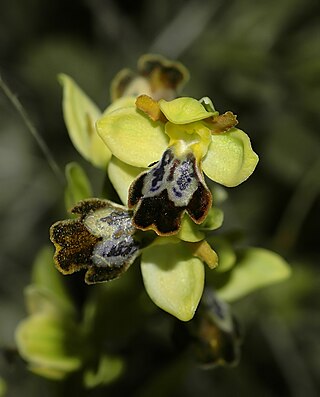
Ophrys fusca, commonly known as the sombre bee-orchid or the dark bee-orchid, is a species of orchid native to the Mediterranean from southwestern Europe and northern Africa to western Asia. Most subspecies of the Ophrys fusca are pollinated by males Andrena bees.

Colletes hederae, the ivy bee, is a species of plasterer bee belonging to the family Colletidae subfamily Colletinae.

Colletes halophilus, the sea aster mining bee, is a rare species of mining bee from the family Colletidae which is found around the margins of saltmarsh and other coastal habitats in south-eastern England and north-western Europe. It is threatened by rising sea levels and human development which reduce its food plant sea aster and destroy its nesting areas.

Colletes succinctus, the common colletes or heather colletes, is a species of Palearctic mining bee from the family Colletidae. It is part of the succinctus species group within the genus Colletes and is especially closely related to the ivy bee and the sea aster mining bee which are partially sympatric with C. succinctus but ecologically separate.
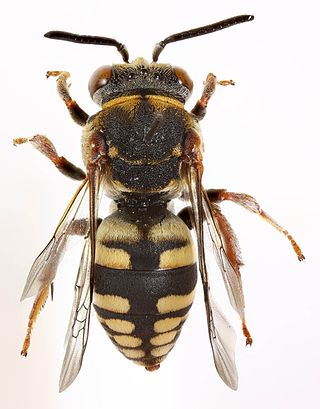
Epeolus cruciger, the red-thighed epeolus, is a species of cuckoo bee from the family Apidae. It is endemic to Europe, where its main host is the common colletes, although other species of Colletes mining bees have been recorded as hosts.

Epeolus is a genus of cuckoo bees in the family Apidae. They are often known as variegated cuckoo-bees.

Stenoria analis, the ivy bee blister beetle, is a species of blister beetle from the family Meloidae which is found in western Europe and North Africa and is a specialist cleptoparasite of the ivy bee larvae. Its occurrence in regions outside of the known range of the ivy bee, for example in North Africa, suggest that it has other hosts.
Colletes slevini, or Slevin's cellophane bee, is a species of hymenopteran in the family Colletidae. It is found in North America.

Colletes validus, colloquially known as the blueberry cellophane bee, is a solitary, specialist bee in the family Colletidae. It is found primarily in eastern North America where it nests in sandy soils near ericaceous plants.
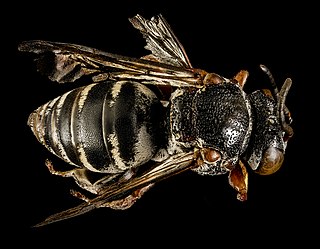
Epeolus lectoides, the cuckoo bee, is a species of cuckoo bee in the family Apidae. It is found in North America. Hosts include Colletes latitarsis and Colletes nudus.

Colletes solidaginis, the goldenrod cellophane bee, is a species of hymenopteran in the family Colletidae. It is found in North America.
Colletes longifacies is a species of hymenopteran in the family Colletidae. It is found in North America. The species is one of five from the family Colletidae that are endemic to the state of Florida. The species occurs in North-Central Peninsular Florida and the Panhandle.
Colletes fulgidus is a species of hymenopteran in the family Colletidae. It is found in North America.

Colletes kincaidii, or Kincaid's cellophane bee, is a species of hymenopteran in the family Colletidae. It is found in North America.
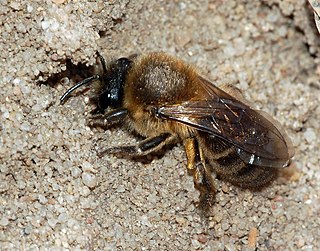
Colletes cunicularius, the vernal colletes or spring mining bee, is a species of solitary bee from the family Colletidae which is widespread in the Palearctic from Britain to the Pacific Ocean which nests in areas of open, sandy soil.
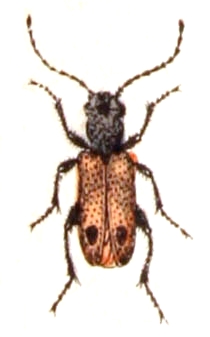
Apalus bimaculatus, the early blister beetle, is a species of blister beetle from the family Meloidae. It is the type species of the genus Apalus.
















